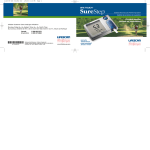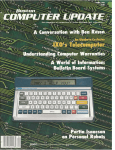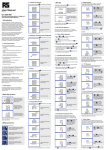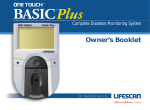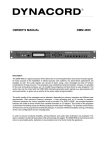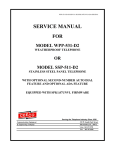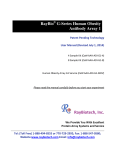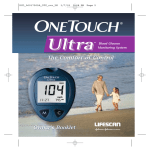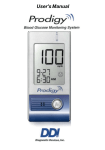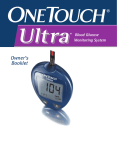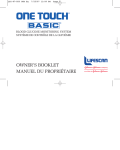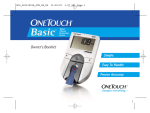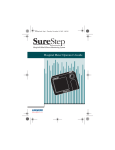Download Lifescan SureStep blood glucose monitoring system User's Manual
Transcript
LSI-98-090 SS booklet.B 7/13/98 11:41 AM Page T1 Owner’s Booklet LSI-98-090 SS booklet.B 7/13/98 11:41 AM Page T3 The SURESTEP ® System is intended for use outside the body (in vitro diagnostic use). It should be used only for testing purposes and only with fresh whole blood samples. It should not be used for the diagnosis of diabetes. LSI-98-090 SS booklet.B 7/13/98 11:41 AM Welcome to LifeScan Congratulations! You’ve chosen a product made by LifeScan, a leading company in providing products to help you manage your diabetes. SURESTEP® blood glucose monitoring products are widely available without a prescription. Blood glucose monitoring plays an important role in controlling your diabetes. A recent study showed that keeping blood glucose levels close to normal can reduce the risk of complications by up to 60%. The results you get with the SURESTEP® System can help you and your healthcare professional Page T4 monitor and adjust your treatment plan to gain better control of your diabetes. Everything you need to know about using the SURESTEP System is included in this booklet. A free instructional videotape is also available by calling LifeScan Customer Services. If you have any questions, please feel free to call the toll-free numbers to speak with our Customer Services Department. Remember to complete and mail the Warranty Registration Card. A complimentary gift is sent when we receive your Warranty Registration Card. Important phone numbers: Meter Serial Number _______________ LifeScan Customer Services (24 hours a day, 7 days a week): USA English 1 800 227-8862 Español 1 800 381-7226 Healthcare professional ________________________ Pharmacist _________________________ Diabetes educator _____________________________ Other ______________________________ LSI-98-090 SS booklet.B 7/13/98 11:41 AM Page T5 CAUTION: Before using any product to test your blood glucose (blood sugar), read all instructions and practice the test. Do all quality control checks as directed and consult with a diabetes healthcare professional. These recommendations apply to all blood glucose monitoring systems and are supported by the American Association of Diabetes Educators, the American Diabetes Association, the U.S. Food and Drug Administration, and the Health Industry Manufacturers Association. IMPORTANT: If you have followed the tips to ensure accuracy and your blood glucose results are still out-of-range, call your healthcare professional. The SURESTEP® System contains many small parts: test strip holder, battery door, batteries, PENLET® II Cap, lancets, control solution vial, test strips, test strip bottle cap, etc. Keep the system out of the reach of small children because these parts may be dangerous if swallowed. If using a 10% bleach solution to disinfect the meter, be sure to completely remove any bleach from the meter and test strip holder with a cloth dampened with water. Bleach will react with the test strips and cause inaccurate results. LSI-98-090 SS booklet.B 7/13/98 11:41 AM Page T7 TA B L E O F C O N T E N T S LEARNING THE SYSTEM SURESTEP® Blood Glucose Meter SURESTEP® Test Strips Display Symbols 1 3 4 6 CODING THE METER Three Easy Steps to Coding 10 SURESTEP® Glucose Control Solution Control Solution Test Control Solution Range 12 12 17 Getting a Drop of Blood Step-by-Step Test Procedure Optional Color Chart 18 24 32 CHECKING THE SYSTEM Glucos Shake befor Not Intende Discard 3 m Discard date Lot No. Exp. Date © LIFESCAN I TESTING YOUR BLOOD LifeScan Customer Services (24 hours a day, 7 days a week): USA English 1 800 227-8862 Español 1 800 381-7226 LSI-98-090 SS booklet.B 7/13/98 11:41 AM UNDERSTANDING YOUR RESULTS RECALLING RESULTS FROM METER MEMORY Page T8 Overview Comparing Meter and Laboratory Results Expected Test Results (Target Range) Testing Tips to Ensure Accuracy Health Conditions Causing Out-of-Range Results Recommendations for Better Diabetes Control 34 35 36 38 Using the Meter for the First Time Recalling All Results in Meter Memory Recalling Your Last Result 42 43 44 General Care Cleaning the Meter Changing the Batteries 45 45 49 39 41 CARING FOR YOUR METER LifeScan Customer Services (24 hours a day, 7 days a week): USA English 1 800 227-8862 Español 1 800 381-7226 LSI-98-090 SS booklet.B 7/13/98 11:41 AM CHANGING METER SETTINGS (Set-Up Mode) Page T9 Entering Set-Up Mode Display of Last Result Unit of Measurement (mg/dL or mmol/L) Beep Signals 52 53 53 54 55 Helpful Messages Error Messages 57 59 Performance Characteristics Guarantee and Warranty 64 65 SOLVING PROBLEMS SPECIFICATIONS QUICK REFERENCE GUIDE LifeScan Customer Services (24 hours a day, 7 days a week): USA English 1 800 227-8862 Español 1 800 381-7226 67 LSI-98-090 SS booklet.B 7/13/98 11:41 AM Page T10 LSI-98-090 SS booklet.B 7/13/98 11:41 AM T H E S Y S T E M the measurement used by most clinical laboratories. Easy-to-understand symbols guide you through the test procedure and help you if any problems arise. The SURESTEP® Blood Glucose Monitoring System is the next advance in the self-monitoring of blood glucose. The SURESTEP System is for people with diabetes who need to check the level of sugar (glucose) in their blood. A drop of blood is taken from the finger and placed on a SURESTEP® Test Strip, which is then inserted into the SURESTEP® Blood Glucose Meter. The meter measures the blood glucose level and displays the result on average in 30 seconds. The system is calibrated to give a plasma value, SURESTEP Test Strips are the only test strips that have been specifically designed, developed, and tested for use with the SURESTEP Meter to ensure consistent quality and accuracy. For reliable results and to maintain the manufacturer’s complete service, support, and warranty, use only SURESTEP Test Strips made by LifeScan. 1 LEARNING L E A R N I N G Page 1 7/13/98 11:41 AM Page 2 Color Chart LEARNING LSI-98-090 SS booklet.B QUICK REFERENCE* BEFORE TESTING: See inside for instructions on proper blood application and coding the meter. Lancets Inside Tray © LIFESCAN IN Shake before Not Intended Discard 3 mo Discard date: Lot No. Exp. Date Glucose * IMPORTANT: Read detailed instructions in your SureStep® Owner’s Booklet before doing a test. Extra Space for Diabetes Supplies and Syringes 2 LSI-98-090 SS booklet.B 7/13/98 11:41 AM Page 3 C BUTTON (Green) Codes the meter, changes the meter settings, and scrolls through the memory. Front POWER BUTTON (Blue) Turns the meter on and off. DISPLAY Shows your test results and symbols that guide you through the test. CONTACT POINTS Sense the position and orientation of the SURESTEP® Test Strip. LENS AREA Contains the meter optics that read the glucose level. Test strip holder covers the lens area. TEST STRIP HOLDER Closed Opened Cover SERIAL NUMBER (Example) BATTERY COMPARTMENT Holds two AAA alkaline batteries. L 5037 ZG 00171 Back BLOOD GLUCOSE METER Toll-free customer service: UNITED STATES: English 1 800 227-8862 Test Strip Insertion Point Español 1 800 381-7226 CANADA: 1 800 663-5521 Milpitas, CA 95035 C22.2 No. 125; Risk Class 2 ÿ LIFESCAN INC. 1995 AW 052-178-01A Made in U.S.A. ® 3 Base The cover protects the lens area and the base holds the SURESTEP Test Strip. LEARNING SURESTEP® Blood Glucose Meter LEARNING LSI-98-090 SS booklet.B 7/13/98 11:41 AM Page 4 dot on the back of the test strip and is read by the meter to determine the blood glucose level; the darker the color, the higher the blood glucose level. SURESTEP® Test Strips When blood is applied to the pink test square, it is absorbed and a chemical reaction takes place. A blue color forms in the confirmation White Tip is inserted into the meter. The side where you apply blood must be face up when you insert the test strip. Pink Test Square is where you apply a drop of blood. Black Tip helps the BACK FRONT White Tip Black Tip Pink Test Square Confirmation Dot White Pad absorbs the excess blood that may extend beyond the pink test square. Do not apply blood directly onto the white pad. White Pad 4 meter detect that the strip has been inserted properly. Confirmation Dot on the back of the test strip is where you check to confirm proper blood application. When it turns completely blue, enough blood has been applied for an accurate test. LSI-98-090 SS booklet.B 7/13/98 11:41 AM Page 5 ■ ■ ■ ■ ■ ■ ■ ■ ■ ■ Contact with air, moisture, and light can cause false results. Keep test strips sealed in the original moisture-resistant, light-protected package and store in a cool, dry place not above 86° F (30° C). Do not refrigerate, place in direct heat or sunlight, or leave bottle open. DO NOT use SURESTEP® Test Strips beyond the expiration date. If using test strips from a bottle, write the discard date on the bottle label. Discard unused test strips 4 months after first opening the bottle. DO NOT use SURESTEP Test Strips that are bent, torn, cut, or changed in any way. Before testing, the confirmation dot should be off-white. DO NOT use test strip if confirmation dot is darker than the color of an unused test strip shown on the Color Chart included with the test strip package. Use each test strip immediately after removing it from the package. Replace the test strip bottle cap immediately after removing a test strip and close the cap tightly. Never transfer test strips to a new bottle or any other container. DO NOT use bleach, or products containing bleach, with the test strips. For reliable results, use only SURESTEP Test Strips made by LifeScan. 5 LEARNING IMPORTANT TEST STRIP INFORMATION LEARNING LSI-98-090 SS booklet.B 7/13/98 11:41 AM Page 6 Display Symbols The SURESTEP® Blood Glucose Meter uses symbols to guide you through a test and to help you determine if something is wrong with your test strip or meter. To check that all display symbols are working, press and hold down the power button. All of these symbols should appear. Call LifeScan Customer Services at 1 800 227-8862 if any segments are missing. 6 LSI-98-090 SS booklet.B 7/13/98 11:41 AM Page 7 Code Number. The number on the display must match the code number on your SURESTEP® Test Strip package. It must be checked every time you use a new package of test strips and changed if the code number is different. (Example) (Example) 7 LEARNING Meter Memory Result. Your SURESTEP® Meter stores up to 10 blood glucose or control solution test results in its memory. Every time you turn the meter on, it will automatically recall and display your last (most recent) result. LEARNING LSI-98-090 SS booklet.B 7/13/98 11:41 AM Page 8 Meter Is Reading Your Result. The result appears, on average, in 30 seconds. The clock may flash longer at cooler temperatures or shorter at warmer temperatures. Apply Blood Sample to Pink Test Square. Push the Test Strip, Pink Side Up, Firmly into the Test Strip Holder Until It Stops. If you fail to completely insert the test strip, the test may start. However, you may receive an inaccurate low result. Test Result. The meter displays results between 0–500 mg/dL (0–27.8 mmol/L). (Example) 8 LSI-98-090 SS booklet.B 7/13/98 11:41 AM Page 9 Replace the Two AAA Alkaline Batteries. (Example) When proper procedures are followed, a reading of “ ” means very high blood glucose (severe hyperglycemia). In extremely rare circumstances, the meter will read “ ” instead of “ ” above 500 mg/dL (27.8 mmol/L). Compare the color of the test strip confirmation dot with the Color Chart on the test strip package (see pages 32–33). 9 LEARNING Clean Meter and Test Strip Holder. HI mg/dL. In virtually all cases above 500 mg/dL (27.8 mmol/L), the meter reads “ .” LSI-98-090 SS booklet.B 7/13/98 11:41 AM Page 10 CODING CODING THE METER Three Easy Steps to Coding Code numbers are used to calibrate the SURESTEP® Test Strip with the SURESTEP® Meter for accurate results. You must code the meter before using it for the first time. You must check the code every time you change to another package of test strips. Check that the code number on the display matches the code number on the test strip package. Step 1: Turn on the Meter. Press the blue power button. The result from your last blood glucose or control solution test will appear. (Example) Next, the meter code will appear for a few seconds. Caution: If the code numbers do not match, you may get inaccurate results. (Example) 10 LSI-98-090 SS booklet.B 7/13/98 11:41 AM Page 11 Step 2: Check the Code Numbers. Step 3: Code the Meter. The code number on the test strip package will range from 1 to 21. If the number on the display matches the code number on the SURESTEP® Test Strip package, begin testing. If the two code numbers do not match, follow Step 3 to code the meter. After the CODE symbol appears, press the green C button. Continue pressing until the code number on the display matches the code number on the test strip package. ▼ C Button CODING (Example) The code is now set for the package of test strips you are using. The meter will retain this code until you change it. (Example) 11 LSI-98-090 SS booklet.B 7/13/98 11:41 AM Page 12 CHECKING THE SYSTEM The SURESTEP® System does not require a check strip. The meter performs an automatic check every time you turn it on. Control Solution Test CHECKING SURESTEP® Glucose Control Solution Control solution is used instead of blood to tell you that the SURESTEP® Blood Glucose Meter and SURESTEP® Test Strips are working together properly. The control solution contains a known amount of glucose that reacts with a SURESTEP Test Strip. Glucos SURESTEP Glucose Control Solution Shake befor Not Intende Discard 3 m Discard date Lot No. Exp. Date © LIFESCAN I 12 Do a control solution test: ■ Before testing with the SURESTEP Blood Glucose Meter for the first time. ■ Every time you open a new package of test strips. ■ Whenever you suspect that the meter or test strips are not working properly. ■ When your results do not reflect how you feel. ■ If you drop the meter. LSI-98-090 SS booklet.B 7/13/98 11:41 AM Page 13 IMPORTANT CONTROL SOLUTION TEST INFORMATION ■ ■ ■ ■ ■ Use only SURESTEP® Glucose Control Solution. Check the expiration date. Write the discard date on the vial. Do not use if expired. Discard the vial 3 months after first opening it. The control range printed on the test strip bottle is for SURESTEP Glucose Control Solution only. It is NOT a recommended range for your blood glucose level. Do not store the glucose control solution at room temperatures above 86° F (30° C). Do not refrigerate or freeze. If a control solution test falls outside of the control range, do not use the meter to test your blood until you get a control solution test result within the range. Call LifeScan Customer Services at 1 800 227-8862 if you need assistance. Warnings ■ ■ Control solution is NOT TO BE USED as a cleaning solution. DO NOT swallow or inject control solution or put it in your eyes. Control solution contains a dye that stains clothing. 13 CHECKING ■ LSI-98-090 SS booklet.B 7/13/98 11:41 AM Step 1: Apply a Small Drop of Control Solution. Follow the test procedure, using SURESTEP® Glucose Control Solution instead of blood. After shaking the control solution vial, apply one drop of control solution to the pink test square. Before Testing, Check the Code. After turning the meter on, the last result appears, followed by the CODE symbol and number. If the code on the meter does not match the code on the test strip package, press the green C button until the codes match. Note: Applying too much control solution may cause out-of-range results and dirty the meter. ▼ C Button CHECKING Page 14 (Example) 14 LSI-98-090 SS booklet.B 7/13/98 11:41 AM Step 2: Check Confirmation Dot. Check to see that the confirmation dot on the back of the test strip has turned completely blue to ensure you have applied enough control solution. Page 15 Step 3: Insert the Test Strip and Read Result. Within two minutes after applying control solution, insert the test strip firmly into the test strip holder, pink side up, until it comes to a complete stop. CHECKING 15 LSI-98-090 SS booklet.B 7/13/98 11:41 AM Page 16 Compare the control solution test result with the control range printed on the SURESTEP® Test Strip package. The control solution result appears, on average, in 30 seconds. SURESTEP Control Range (Example) (Example) CHECKING Note: Do not use the Color Chart to verify control solution tests. 16 LSI-98-090 SS booklet.B 7/13/98 11:41 AM When the control solution test result is within the control range, you are ready to test your blood. Your control solution test will be stored in the meter memory. Record control solution tests in your logbook by placing a C next to the result to indicate a control solution test. Control Solution Range TEST TEST LT RESU TIME S NOTE IN/ INSUL N TIO MEDICA DATE TEST TEST LT RESU TIME IN/ INSUL N TIO MEDICA 17 CHECKING If test results fall outside the expected range, repeat the test. Results that fall outside the expected range may indicate the system is not working properly. Some possible causes are: ■ Procedural error ■ Expired or contaminated control solution ■ Test strip code and meter code do not match ■ Dirty meter or test strip holder ■ Test strip deterioration ■ Meter malfunction ■ Control solution that is outside of the temperature range 59–95˚F (15–35˚C) If you are unable to resolve the problem, call LifeScan Customer Services, 1 800 227-8862. S NOTE DATE Page 17 TESTING LSI-98-090 SS booklet.B 7/13/98 11:41 AM Page 18 TESTING YOUR BLOOD Step 1: Insert a Lancet in the PENLET® II Automatic Blood Sampler. Getting a Drop of Blood IMPORTANT: Getting an adequate drop of blood is one of the most important steps in getting an accurate result. CAUTION: ■ Use a new, sterile lancet every time you test. ■ Do not use lancet if protective disk has been removed or damaged. ■ Never use a lancet that has been used by someone else. ■ If you share a PENLET® II, each person should always use a new lancet and a new or properly disinfected cap. ■ For assistance, call LifeScan Customer Services, 1800227-8862. Remove the PENLET® II Cap by pulling it straight off. 18 LSI-98-090 SS booklet.B 7/13/98 11:41 AM Hold the lancet firmly, and gently twist and pull off the protective disk. Note: Save the protective disk for safe removal of the lancet after testing. 19 TESTING Insert a new, sterile lancet into the lancet holder. Page 19 TESTING LSI-98-090 SS booklet.B 7/13/98 11:41 AM Page 20 Step 2: Cock the PENLET ® II Sampler. Choose either the regular or deep penetration PENLET® II Cap and slide it back onto the PENLET II Sampler. Holding the lower portion of the PENLET II Sampler, pull out the dark gray sliding barrel until it clicks. If it does not click, the PENLET II Sampler may have been cocked when the lancet was inserted. Regular Deep Penetration 20 LSI-98-090 SS booklet.B 7/13/98 11:41 AM Wash your hands with soap and warm water and dry them thoroughly. Warm water stimulates blood flow to the fingers. Hang your arm down for 10–15 seconds before you stick your finger. If you use alcohol to clean your finger, make sure you let it dry. To avoid soreness, choose a site on the side of your fingertips. To avoid calluses, choose a different spot each time you test. 21 TESTING Step 3: Get a Drop of Blood. Page 21 TESTING LSI-98-090 SS booklet.B 7/13/98 11:41 AM Page 22 By holding your hand down and kneading your palm, blood will flow more quickly and easily to your finger. If necessary, squeeze the finger gently. Hold the PENLET® II Sampler firmly against the side of the finger, with the cap resting on the finger. (The harder you press, the deeper the puncture.) Press the dark gray release button. Proceed with the blood glucose test. For information, see pages 24–33. 22 LSI-98-090 SS booklet.B 7/13/98 11:41 AM When removing the PENLET® II Cap, be careful not to prick yourself or anyone else. After removing the cap, grasp the two dark gray prongs located near the release button, pointing the lancet down and away from you. Pull back on the dark gray sliding barrel until the lancet drops out. Another way to remove the lancet is to put the protective disk back on the lancet. Place the disk on a hard surface and gently stick the lancet needle into the protective disk. Now carefully pull the lancet out. Discard the used lancet in a container for sharp objects. 23 TESTING Step 4: Remove the Lancet. Page 23 TESTING LSI-98-090 SS booklet.B 7/13/98 11:41 AM Page 24 Choose a clean, dry work surface. Make sure you have your: Step-by-Step Test Procedure When learning to use the meter for your own diabetes care, first do a control solution test. When the control solution test result is within the control range, you are ready to practice by testing your blood. Next you should perform three blood glucose tests in a row. You will know you have applied blood correctly when the confirmation dot turns completely blue and you obtain a glucose result from the meter. Unused, sterile lancet SURESTEP® Blood Glucose Meter SURESTEP® Test Strip 24 PENLET® II Sampler LSI-98-090 SS booklet.B 7/13/98 11:41 AM Press the blue power button. Next, the code number appears. It must match the code number on the SURESTEP® Test Strip package. If it does not match, change the meter code number following the instructions on pages 10–11. Your last test result will appear. (Example) (Example) 25 TESTING Before Testing. Page 25 TESTING LSI-98-090 SS booklet.B 7/13/98 11:41 AM Page 26 Step 1: Apply Blood to the Test Strip. Then these symbols will alternate on the display: Apply a drop of blood to the center of the pink test square. Note: Do not add more blood to the first drop. Adding more blood may give false results. Apply blood to test strip. Insert test strip into meter. The meter is ready for a test. You have two minutes to insert the test strip before the meter automatically turns off. 26 LSI-98-090 SS booklet.B 7/13/98 11:41 AM Page 27 1) Hold the test strip under your finger and touch the drop of blood to the pink test square. OR 2) Turn the test strip over and dab the pink test square to the finger. You can touch the test strip. The pink test square will quickly absorb the blood and the confirmation dot will begin changing color. 27 TESTING You can apply blood to the pink test square in one of two ways. TESTING LSI-98-090 SS booklet.B 7/13/98 11:41 AM Page 28 Step 2: Check the Confirmation Dot. You have applied too much blood to the test strip if the entire white pad is soaked. You must begin the test with a new test strip to avoid false results from too much blood. After a few seconds, look at the confirmation dot on the back of the test strip. If it is completely blue, go on with the test. Too Much Blood Enough Blood Confirmation Dot Front Front 28 Back LSI-98-090 SS booklet.B 7/13/98 11:41 AM Page 29 Turn the SURESTEP® Test Strip to the front side and slide it into the test strip holder, pink side up. Push the test strip in firmly until it stops. Insert the test strip within two minutes after applying blood to obtain an accurate result. Not Enough Blood Caution: If you do not insert the test strip properly, you may get an inaccurate result. 29 TESTING Step 3: Insert the Test Strip and Read Result. If any white patches or white streaks appear on the confirmation dot, you have not applied enough blood for an accurate test. You must start the test over with a new test strip. TESTING LSI-98-090 SS booklet.B 7/13/98 11:41 AM Page 30 Note: Your meter is designed to give accurate results at temperatures between 50° and 95°F (10–35°C). At the higher end of this temperature range the test time may be as short as 15 seconds. At the lower end of this temperature range, the test time will be extended. The flashing clock symbol appears while the meter is reading your result. You will hear a three-tone beep when the meter displays your result. Results appear, on average, in 30 seconds. (Example) The SURESTEP® System is calibrated to give plasma values. Because most clinical laboratories measure plasma glucose, the SURESTEP System enables you to more directly compare meter results with lab results. See pages 35–36 to learn how to compare meter and lab results. The meter displays results between 0 and 500 mg/dL. In virtually all cases above 500 mg/dL, the meter reads “ .” 30 LSI-98-090 SS booklet.B 7/13/98 11:41 AM Page 31 S NOTE DATE TEST TEST LT RESU TIME S NOTE N/ INSULI ION MEDICAT DATE TEST TEST LT RESU TIME N/ INSULI ION MEDICAT 31 i. Kahn, R., and Weir, G.: Joslin’s Diabetes Mellitus, 13th ed. Philadelphia: Lea and Febiger (1994), 489. ii. Krall, L.P., and Beaser, R.S.: Joslin Diabetes Manual. Philadelphia: Lea and Febiger (1989), 261-263. TESTING IMPORTANT: When proper procedures are followed, the meter will display “ ” when your result is above 500 mg/dL (27.8 mmol/L). This indicates very high blood glucose (severe hyperglycemia). Low and High Blood Glucose: Test results below 60 mg/dLi (3.3 mmol/L) mean low blood glucose (hypoglycemia). Test results greater than 240 mg/dLii (13.3 mmol/L) mean high blood glucose (hyperglycemia). If you get results below 60 mg/dL or above 240 mg/dL and you do not have symptoms that match your results, repeat the test following the guidelines on pages 38–39 to ensure testing accuracy. You may also use the Color Chart (see pages 32–33). If you have symptoms that match your results or if you continue to get results that fall below 60 mg/dL or above 240 mg/dL, follow the treatment advice of your healthcare professional. Record your test result in your LifeScan logbook. The logbook allows you to keep a record of your test results, along with information on your meals and medication. TESTING LSI-98-090 SS booklet.B 7/13/98 11:41 AM Page 32 Press the blue power button to turn off the SURESTEP® Blood Glucose Meter. (To save energy, the meter automatically turns off three minutes after the meter displays your test result.) Optional Color Chart A Color Chart is included with each package of SURESTEP® Test Strips. It is useful as an additional check that your meter and test strips are working properly. The Color Chart is NOT a replacement for a SURESTEP Meter test. The chart shows four shades of blue, each corresponding to a blood glucose level. It also shows an offwhite shade for new, unused test strips. Use the Color Chart in the following two ways. 32 LSI-98-090 SS booklet.B 7/13/98 11:41 AM Page 33 2. After testing. Directly after reading a meter result, you can compare the color of the test strip confirmation dot with the colors on the chart. The color of the confirmation dot will either match one of the colors on the chart or fall between two colors. When the color of the blue dot falls between two colors, your blood glucose Note: If your Color Chart reading and meter result do not agree and do not reflect how you feel, follow the testing tips for accuracy on pages 38–39. Do not use the Color Chart with control solution tests. 33 TESTING level is between the values printed next to the two colors. This comparison will give you a rough estimate of your blood glucose level. 1. Before testing. Compare the confirmation dot on the back of the new test strip to the shade marked unused on the chart. Do not use the test strip if the confirmation dot is darker than the color of an unused test strip on the Color Chart. LSI-98-090 SS booklet.B 7/13/98 11:41 AM Page 34 RESULTS U N D E R S TA N D I N G Y O U R R E S U LT S Overview What This Means for You. Recent Diabetes Findings. Frequent blood glucose testing is the best means you have for keeping track of how well you are doing with the factors that affect your diabetes—medication, diet, exercise, and stress management. Blood glucose test results can also tell you whether your diabetes is changing in ways that might require an adjustment to your treatment plan. Always consult your healthcare professional before making any adjustments. In 1993 the National Institutes of Health concluded an extensive longterm study of people with Type 1 diabetes. This study, called the Diabetes Control and Complications Trial (DCCT), found that by keeping your blood glucose close to the levels of people without diabetes you can reduce the risk of complications involving the eyes, kidneys, and nervous system by approximately 60%.1 34 LSI-98-090 SS booklet.B 7/13/98 11:41 AM Frequency of Testing. Comparing Meter and Laboratory Results The SURESTEP® System’s plasma calibration enables you to more directly compare SURESTEP Meter results with your lab results because most laboratories measure plasma glucose; however, your meter blood glucose test result may be different from your laboratory result (by up to 20%)2 due to normal sources of variation. Make sure you are following Testing Tips to Ensure Accuracy on pages 38–39. To make an accurate comparison between meter and laboratory results, the meter test must be done within 10 to 15 minutes of the laboratory test. If samples are taken more than 15 minutes apart, the two tests could have very different results. Blood glucose levels can change significantly over short periods, especially if you have recently eaten, 35 RESULTS How often you need to test your blood glucose will vary according to your age, the type of diabetes you have, the medications you are taking, and your physical and emotional health. Your healthcare professional will guide you. After you decide when and how often you should test, it is important that you make testing part of your daily routine. Page 35 RESULTS LSI-98-090 SS booklet.B 7/13/98 11:41 AM Page 36 Expected Test Results (Target Range) exercised, taken medication, or experienced stress.3 In addition, if you have eaten recently, the blood glucose level from a fingerstick can be up to 70 mg/dL higher than that of a venous sample (blood drawn from a vein) used for a laboratory test.4 Therefore it is best to fast for eight hours before doing the comparison tests. Factors such as a high or low hematocrit (amount of red blood cells in the blood) or severe dehydration (loss of body fluid) may also cause a meter result to be different from a laboratory result. For more detail, see pages 39–40. Your test results will vary somewhat from test to test. Blood glucose levels change throughout the day. The types and amounts of food you eat, your activity and stress levels, and how much insulin or other medication you take affect your blood glucose levels. If you are controlling your diabetes well, your test results should fall within a personal target range recommended by your healthcare professional. Once you have established your target range, you will be able to detect when your results are high or low and can take action with advice from your healthcare professional. 36 LSI-98-090 SS booklet.B 7/13/98 11:41 AM Page 37 YOUR TARGET RANGES, mg/dL Before breakfast 70–105 ______________________ Before lunch or dinner 70–110 ______________________ 1 hour after meals Less than 160 ______________________ 2 hours after meals Less than 120 ______________________ Between 2 and 4 a.m. Greater than 70 ______________________ 37 RESULTS GLUCOSE RANGES FOR PEOPLE WITHOUT DIABETES,5 mg/dL LSI-98-090 SS booklet.B 7/13/98 11:41 AM RESULTS Testing Tips to Ensure Accuracy Page 38 ■ If you have a test result that falls outside of your target range and you cannot link it to diet, exercise, medication, or stress, repeat the test. If the result is similar and still outside of your range, try these troubleshooting steps: ■ ■ Before Testing: ■ ■ ■ Wash your hands. Use a new, sterile lancet. Check the expiration date on the test strip package. If it has passed, discard the unused test strips and open a new package. When using test strips from a bottle, discard any remaining test strips 4 months after first opening. ■ Make sure the confirmation dot on the unused test strip is not darker than the color of an unused test strip shown on the Color Chart. Make sure the code on the meter matches the code on the test strip package. Do a test with SURESTEP® Glucose Control Solution to verify that the test strip and meter are working properly. Make sure the meter test strip holder, lens area, and contact points are clean. Follow instructions on pages 45–49. After Testing: ■ 38 Make sure you applied enough blood to the test strip by inspecting LSI-98-090 SS booklet.B ■ ■ 7/13/98 11:41 AM IMPORTANT: If you have followed the tips to ensure accuracy and your blood glucose results are still out-of-range, call your healthcare professional. Health Conditions Causing Out-of-Range Results If you are getting results outside your range of expected blood glucose levels, and you are certain that the SURESTEP® Meter and SURESTEP® Test Strips are working together properly, ask yourself the following questions: “How do I feel?” “Do I have symptoms of low blood glucose (hypoglycemia): slurred speech, headache, tingling of lips, cool sweating, rapid heartbeat, disorientation, weakness, dizziness, fainting, hunger, nervousness, irritability, or tremors?” 39 RESULTS the test strip confirmation dot to be certain it turned completely blue. Make sure you did not apply too much blood to the test strip. You have applied too much blood if there is no white visible on the white pad. Directly after the meter displays a result, compare the color of the test strip confirmation dot with the Color Chart on the test strip package (see pages 32–33). Page 39 LSI-98-090 SS booklet.B 7/13/98 11:41 AM “Do I have symptoms of high blood glucose (hyperglycemia): fatigue, dry mouth and skin, increased thirst or hunger, blurry vision, increased urination, rapid deep breathing, or a fruity smell to the breath?” very low hematocrits (below 25%) can cause false results.6 2. Severe dehydration and excessive water loss may cause false low results.7, 8 Severe dehydration, which may lead to many serious medical complications, can be caused by: “What have I eaten?” “How much have I exercised?” RESULTS Page 40 “Am I ill (common cold, flu, etc.)?” ■ Vomiting and diarrhea “Have I been under stress lately?” ■ Prescription drugs (e.g., diuretics) ■ Inability to recognize or respond to “thirst” sensations ■ Uncontrolled diabetes ■ Shock9 In addition to these factors, there are other abnormal conditions that can affect your results. 1. Extremes in hematocrit (the amount of red blood cells in the blood) can affect test results. Very high hematocrits (above 60%) and If you believe you are suffering from severe dehydration, consult a healthcare professional immediately. 40 LSI-98-090 SS booklet.B 7/13/98 11:41 AM Recommendations for Better Diabetes Control ■ ■ ■ ■ ■ References 1. American Diabetes Association position statement on the Diabetes Control and Complications Trial (1993). Follow the advice of your healthcare professional. Follow the exercise and meal plans recommended by your healthcare professional. Take insulin or diabetes medication at your scheduled times. Keep in touch with your emotional and physical condition. Stress or illness can affect diabetes. Watch for symptoms of hypoglycemia (low blood glucose) and hyperglycemia (high blood glucose). Review your logbook of test results with your healthcare professional regularly. 2. Clarke, W.L., et al.: Diabetes Care, Vol. 10, No. 5 (1987), 622-628. 3. Surwit, R.S., and Feinglos, M.N.: Diabetes Forecast (1988), April, 49-51. 4. Sacks, D.B.: “Carbohydrates.” Burtis, C.A. and Ashwood, E.R. (ed.), Tietz Textbook of Clinical Chemistry. Philadelphia: W.B. Saunders Company (1994), 959. 5. Krall, L.P., and Beaser, R.S.: Joslin Diabetes Manual. Philadelphia: Lea and Febiger (1989), 138. 6. LifeScan data on file. 7. Wickham, N.W.R., et al.: Practical Diabetes, Vol. 3, No. 2 (1986), 100. 8. Cohen, F.E., et al.: Diabetes Care, Vol. 9, No. 3 (1986), 320-322. 9. Atkin, S.H., et al.: “Fingerstick glucose determination in shock.” Annals of Internal Medicine, Vol. 114 (1991), 1020-1024. 41 RESULTS ■ Page 41 LSI-98-090 SS booklet.B 7/13/98 11:41 AM Page 42 RECALLING RESULTS FROM METER MEMORY The SURESTEP® Blood Glucose Meter is pre-set to automatically display your last test result when the meter is turned on. You can also review your last result immediately after a new test is completed. The meter stores your 10 most recent blood glucose or control solution test results in its memory. When the memory is full, the oldest result is dropped as the newest is added. Using the Meter for the First Time The first time you turn on your meter the following symbol will appear briefly, showing that there is no test result in the memory: MEMORY This symbol will also appear after turning on your meter when your previous test ended in an error and the meter did not display a result. 42 LSI-98-090 SS booklet.B 7/13/98 11:41 AM Recalling All Results in Meter Memory To access the meter memory, press the blue power button and hold down for five seconds. When the display flashes, release the blue power button. You are now in memory mode. Your most recent result will appear on the display. Press the green C button to scroll through the memory. Each time you press the green C button, a number from most recent (1) to oldest (10) will appear, telling you the order of the test result, followed by the result. Green C Button Result (Example) 43 Order of test result (second most recent) Result (Example) MEMORY Order of test result (most recent test first) Page 43 LSI-98-090 SS booklet.B 7/13/98 11:41 AM If a previous test resulted in an error condition, the error will be stored in the memory. Page 44 Recalling Your Last Result Immediately after completing a test, you can also review your previous test result. Current result (Example) Order of test result (third most recent) Result (Example) With the current test result displayed, press and hold the green C button. Your previous result will appear. MEMORY Green C Button Previous result (Example) 44 LSI-98-090 SS booklet.B 7/13/98 11:41 AM Page 45 Your SURESTEP® Blood Glucose Meter is easy to maintain. However, to keep it in good operating condition, follow these simple rules: Cleaning the Meter Clean the test strip holder (cover and base), lens area, and contact points with water when there is dirt, blood, or lint present. General Care ■ ■ ■ Keep your meter dry and avoid exposing it to extremes in temperature. Do not store your meter or test strips in a car or refrigerator. Dropping the meter could damage its electronics. If you drop your meter, do a control solution test to ensure it is working properly. Do not take the meter apart. Sensitive parts could be damaged, causing false results and voiding the warranty. CAUTION: ■ Use only water when cleaning the meter. Do not get water inside the SURESTEP Meter. Never immerse the meter or hold it under running water. ■ Do not use cleansers or glass cleaners with ammonia. ■ When disinfecting the meter, use a 10% bleach solution (9 parts water, 1 part bleach) and remove with water. 45 MAINTENANCE CARING FOR YOUR METER MAINTENANCE LSI-98-090 SS booklet.B 7/13/98 11:41 AM Page 46 Always clean your meter when this symbol appears: Step 1: Remove the Test Strip Holder. If you are concerned that your test results do not compare with how you feel, clean the meter and do a control solution test to check if it is working properly. Clean the meter using these easy steps: Press down at the top end (near the power button) of the test strip holder and slide it away from the meter. Step 2: Clean the Test Strip Holder. Remove debris from the test strip holder by wiping gently with a cotton swab or cloth dampened with water. 46 LSI-98-090 SS booklet.B 7/13/98 11:41 AM Top of Base Use a cotton swab or a soft cloth dampened with water to wipe the lens area and contact points. Be careful not to scratch the lens area. Dry with a soft cloth or tissue that does not contain lint, lotion, or perfume. Do not use abrasive materials such as paper towels. Bottom of Base Contact Points Inside Cover Gray Area Hole (clean both sides) Lens Area Base 47 MAINTENANCE Step 3: Clean the Lens Area and Contact Points. Make sure you thoroughly wipe the gray area on the inside cover. Wash both sides of test strip holder base; carefully clean around the hole. Dry the test strip holder completely with a soft cloth or lint-free tissue. Cover Page 47 MAINTENANCE LSI-98-090 SS booklet.B 7/13/98 11:41 AM Page 48 Note: You can clean the outside of the meter by lightly wiping it with a damp cloth. Step 4: Replace the Test Strip Holder. Slide the test strip holder into the meter, press down, and push forward at the strip insertion point until you hear a click. Make sure the test strip holder is firmly in place. Make sure it does not extend beyond the meter. Turn on the meter. 48 LSI-98-090 SS booklet.B 7/13/98 11:41 AM Page 49 The SURESTEP® Blood Glucose Meter comes with two AAA alkaline batteries already installed. When this symbol appears Note: If using a 10% bleach solution, this message may indicate that you have not completely removed the bleach residue on the gray area of the inside of the test strip holder cover. Wipe with a cloth dampened with water. the batteries are low and you should replace them as soon as possible. The meter will still provide accurate test results with Changing the Batteries 49 MAINTENANCE If this symbol appears after cleaning the meter, check to see if you inserted the test strip holder completely and securely. The test strip holder may be out of position. See pages 59–63 for error descriptions. Note: Low batteries, dead batteries, and battery removal will not affect the test results stored in the memory. 50 To change the batteries, turn off the meter and turn it over. Follow these steps: Step 1: Remove the Battery Door. Squeeze the tab and lift up. 0171 low batteries. If the symbol is flashing, the batteries are dead and you should replace them immediately. You will not be able to do a test when the symbol is flashing. Replace both batteries with new AAA alkaline batteries. Do not use rechargeable batteries. Page 50 7 ZG 0 7/13/98 11:41 AM L 503 MAINTENANCE LSI-98-090 SS booklet.B ® LSI-98-090 SS booklet.B 7/13/98 11:41 AM Page 51 Step 4: Close the Battery Door. Use your fingers or gently tap the meter on the palm of your hand. Never tap the meter against a hard surface. Insert the two hinges into the slots and press down until the tab catches. 5 9403 ss 2 CA k Cla itas, Ris 1995 .A. Milp o. 125; INC. in U.S e N .2 SCAN Mad C22 LIFE 01A © 178205 AW L 5037 ZG ® 00171 Step 3: Insert New Batteries. Insert two new AAA alkaline batteries, matching the + end of each battery with the + signs inside the meter. 51 MAINTENANCE Step 2: Remove the Old Batteries. LSI-98-090 SS booklet.B 7/13/98 11:41 AM Page 52 C H A N G I N G M E T E R S E T T I N G S (Set-Up Mode) change these settings before entering the set-up mode to avoid having meter settings that do not meet your needs. SETTINGS The SURESTEP® Meter has been pre-set to meet the needs of most users. There are three features you can change. Be sure you want to FEATURE PRE-SET ALTERNATIVE On Off Unit of measurement mg/dL mmol/L Beep signals during testing On Off Automatic display of last result 52 LSI-98-090 SS booklet.B 7/13/98 11:41 AM Page 53 the meter automatically turns off. To re-enter set-up mode, begin with Step 2. Entering Set-Up Mode 1. Make sure the meter is off. 2. Press and hold down the green C button. 3. Press and release the blue power button while holding the C button. 4. Release the C button. Display of Last Result After you release both the power and C buttons, this symbol will flash on the display: In the set-up mode, the current setting for each of the three changeable features is automatically displayed in sequence. Each setting flashes on the display for five seconds. While it flashes, the setting may be changed by pressing the C button. After the last feature is displayed, 53 SETTINGS The SURESTEP® Meter is pre-set to automatically display your last test result when you turn on the meter. LSI-98-090 SS booklet.B 7/13/98 11:41 AM (mg/dL). You have the option to select millimoles per liter (mmol/L), the unit of measurement used in Canada and some European countries. The mmol/L results include a decimal point, but mg/dL results do not. If you wish to turn off the automatic display of your last result, press the C button. This symbol will flash SETTINGS Page 54 In set-up mode the unit of measurement will be the second feature to flash on the display. indicating that the automatic display is turned off. Then, wait for the next feature setting (unit of measurement) to appear. Unit of Measurement The meter is pre-set to display test results in milligrams per deciliter 54 LSI-98-090 SS booklet.B 7/13/98 11:41 AM If you wish to change the unit of measurement to mmol/L, press the C button. This symbol will flash on the display. Beep Signals The SURESTEP® Blood Glucose Meter uses beeping tones to signal various steps in the meter procedures. However, these tones do not indicate that the procedures are being performed correctly. The meter is pre-set to emit three different beep signals: 1. A single short beep signals each step in the test procedure. 2. A single long beep accompanies error messages, a “ ” result, and certain mistakes in doing the test procedure. 3. A three-tone beep sounds when the meter displays a test result and when the meter is in set-up mode on the beep signal feature. 55 SETTINGS Then, wait for the next feature setting (beep signals) to appear. Page 55 LSI-98-090 SS booklet.B 7/13/98 11:41 AM SETTINGS If you want the meter to operate without beeps, enter the set-up mode. After the meter displays the memory and unit of measurement features, the meter will sound a threetone beep and flash this message Page 56 Press the C button to turn off the beep signals. The following display will appear You will hear a three-tone beep when is first displayed. Then it will flash silently until the meter turns off. The meter will continue to use these settings until you change them. 56 LSI-98-090 SS booklet.B 7/13/98 11:41 AM Page 57 S O LV I N G P R O B L E M S When any of the following symbols or error messages appear, there may be a problem with the meter, test strip, or the way in which you are doing the procedure. These messages help to identify certain problems but do not appear in all cases when a problem has occurred. In most cases, a problem is easy to solve. Assistance is available from LifeScan Customer Services 24 hours a day at 1 800 227-8862. Helpful Messages SYMBOL MESSAGE WHAT TO DO The test strip was not fully inserted. Push the test strip in firmly until it stops. MESSAGES 57 LSI-98-090 SS booklet.B MESSAGES SYMBOL 7/13/98 11:41 AM Page 58 MESSAGE WHAT TO DO 1. The test strip was inserted before the meter was turned on or before the insert test strip symbol appeared, or 1. Remove the test strip and reinsert the strip after this symbol appears. 2. The test strip was inserted incorrectly, or 2. Reinsert the test strip, tip first, with the pink side facing up. 3. The test strip was inserted too quickly. 3. Reinsert test strip slowly. If the symbol is constant, the batteries are low. If the symbol is flashing, the batteries are dead. Replace the batteries (see pages 49–51). 58 LSI-98-090 SS booklet.B 7/13/98 11:41 AM Page 59 Error Messages The meter gives specific error messages when it detects a problem with its internal functions, the test strip, or the testing procedure. However, improper use may cause an inaccurate ERROR POSSIBLE CAUSE result without producing an error message or a symbol. When error messages appear, note the error number, turn off the meter, then resolve the error by following these instructions: WHAT TO DO 1. Blood was applied to 1. Clean the meter. Repeat the test the wrong side of the with a new test strip, applying test strip, or blood to the pink test square. 2. Not enough blood is on the test strip, or Pink Test Square 59 MESSAGES 2. Repeat the test with a new test strip. Apply a larger drop of blood to the pink test square and Confirmation Dot verify that the confirmation dot on the back of the test strip has turned completely blue. LSI-98-090 SS booklet.B MESSAGES ERROR 7/13/98 11:41 AM POSSIBLE CAUSE Page 60 WHAT TO DO 3. The test strip was inserted more than 2 minutes after applying blood, or 3. Repeat the test with a new test strip. Insert it within 2 minutes after applying blood. 4. You may have a very high blood glucose level, possibly exceeding 500 mg/dL. 4. Do a visual check of the color of the confirmation dot versus the Color Chart on the test strip package. A color that matches or is darker than the 350 mg/dL color on the chart indicates a high blood glucose level. Follow the treatment advice of your healthcare professional. 1. Not enough blood was applied to the test strip, or Confirmation 1. Repeat the test with a Dot new test strip. Apply a larger drop of blood to the pink test square and verify that the confirmation dot on the back of the test strip has turned completely blue. 60 LSI-98-090 SS booklet.B ERROR 7/13/98 11:41 AM Page 61 POSSIBLE CAUSE WHAT TO DO 2. The test strip has been altered, exposed to air, or has passed its expiration date. 2. Check the expiration date on your test strip package. Do not store test strips outside of the original bottle. Do not alter test strips. 1. The test strip was removed or partially removed before the result was displayed, or 1. Do not remove the test strip until the meter displays the result. 2. The meter contact points are dirty. 2. Clean meter contact points. 61 MESSAGES Note: If more than two minutes have passed since you applied blood to the test strip, repeat the test with a new test strip. LSI-98-090 SS booklet.B MESSAGES ERROR 7/13/98 11:41 AM Page 62 POSSIBLE CAUSE WHAT TO DO The meter is not within the temperature range of 50–95°F (10–35°C). Allow the meter to warm or cool slowly before performing another test. Do not apply heat or cold to the meter or test strips. 1. The meter test strip holder, lens area, and contact points are dirty, or 1. Clean; refer to pages 45–49. 2. The test strip holder is not fully in place, or 2. Slide the test strip holder into the meter until it is completely inserted. 62 LSI-98-090 SS booklet.B ERROR 7/13/98 11:41 AM Page 63 POSSIBLE CAUSE WHAT TO DO 3. The test strip was partially inserted before turning the meter on. 3. Remove test strip and turn meter off. Turn meter on, then reinsert test strip when insert test strip symbol appears. A possible failure has occurred in the meter. Turn meter on. Before testing, check that the code on your meter matches the code on your test strip package. If continues, call LifeScan Customer Services at 1 800 227-8862. MESSAGES 63 SPECIFICATIONS LSI-98-090 SS booklet.B 7/13/98 11:41 AM Page 64 S P E C I F I C AT I O N S Performance Characteristics Calibration: Plasma equivalent. See the SURESTEP Test Strip package insert for accuracy and precision information. Hematocrit Range: 25–60%. ® Power Supply: Two AAA alkaline batteries. Dimensions: Length, 3.5 inches; Width, 2.4 inches; Height, 0.80 inches; Weight, 3.8 ounces with batteries. Battery Life: Approximately 18 months when doing two tests a day. Operating Temperatures: 50–95˚ F (10–35˚ C). Result Range: 0–500 mg/dL (0–27.8 mmol/L). Higher results are displayed as “ .” Operating Humidity Range: 10–90% relative humidity (noncondensing). Display: Liquid crystal. Memory: 10 test results. Blood Source: Whole blood. 64 LSI-98-090 SS booklet.B 7/13/98 11:41 AM Guarantee and Warranty 30-Day Money-Back Guarantee Three-Year Warranty If, at any time during the first three years after purchase, the meter does not work for any reason (except for obvious abuse), LifeScan will replace it with a new meter or equivalent product free of charge. The Warranty Policy applies only to the original purchaser of this meter and does not include the batteries supplied with the meter. Please complete the Warranty Registration Card and mail it to LifeScan. The SURESTEP Meter has a full three-year warranty from the original date of purchase. Write your date of purchase here: ________________________________ 65 WARRANTY If you are not fully satisfied with the SURESTEP® System, a full refund may be obtained by calling a LifeScan Customer Services Representative at the toll-free number within 30 days of purchase. After calling LifeScan, you will need to return the SURESTEP® Meter and a copy of your receipt to receive a refund. Page 65 WARRANTY LSI-98-090 SS booklet.B 7/13/98 11:41 AM Page 66 This warranty is in lieu of all other warranties, express or implied, including any implied warranty of merchantability or fitness for a particular purpose. The Warranty Policy does not apply to the performance of the SURESTEP® Meter when used with any test strip other than SURESTEP® Test Strips from LifeScan, or when the SURESTEP Meter or Test Strips are modified in any way. Before you return your meter, or any product, first call your LifeScan Customer Services Representative at the toll-free number for instructions. 66 LSI-98-090 SS booklet.B 7/13/98 11:41 AM Page 67 3-STEP TEST PROCEDURE CODING THE METER Before testing, make sure the meter is coded correctly. 1 Press power button and apply blood to pink test square. 1 Press power button. 2 Meter automatically displays last test result. 2 Check confirmation dot on back of test strip. 3 Firmly insert test strip pink side up, until it comes to a complete stop, and read result (30-second average test time). C Button → (Example) 3 Code number is automatically displayed. (Example) 4 Press C button until code number on meter matches code number on test strip package. 67 QUICK REFERENCE (Example) LSI-98-090 SS booklet.B 7/13/98 11:41 AM Page 68 BLOOD APPLICATION How you can be sure that you have applied the right amount of blood: QUICK REFERENCE Front Back Not Enough Blood Enough Blood Too Much Blood* Pink Test Square Back White Pad Confirmation Dot Pink test square is where you apply a drop of blood. White pad absorbs the excess blood that may extend beyond the pink test square. Do not apply blood directly onto the white pad. Front Back Apply a drop of blood to the pink test square on the front of the test strip. The confirmation dot on the back should be completely blue for an accurate test. Front If any white patches or streaks appear on the blue confirmation dot, you have not applied enough blood for an accurate test. You must start the test over with a new test strip to avoid false low results. Confirmation dot on back of test strip is where you check to confirm proper blood application. 68 If there is no white visible on the white pad, you have applied too much blood. You must start the test over with a new test strip to avoid false high results. * Be careful not to apply too much blood, especially if you tend to bleed easily or are taking blood-thinning medications. LSI-98-090 SS booklet.B 7/13/98 11:41 AM Page 70 El Folleto para el Propietario del SURESTEP® se encuentra disponible en español. Para recibir su copia gratuita, favor del llamar al número gratis 1 800 381-7226. The SURESTEP instructional materials are available in Spanish. To receive your free copy, please call toll-free 1 800 381-7226. LifeScan Customer Services toll-free numbers: (24 hours a day, 7 days a week) U.S.A. English 1 800 227-8862 Español 1 800 381-7226 Milpitas, California 95035 Printed in U.S.A. *05225103A* AW 052-251-03A Patents Pending © LIFESCAN INC. 1998













































































